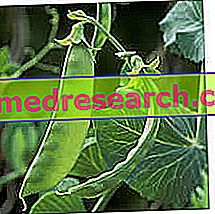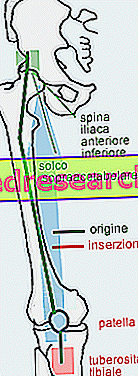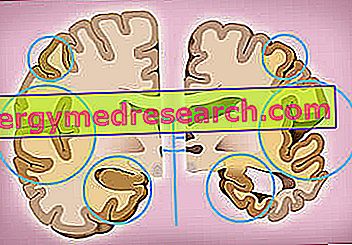Introduction
It was precisely from the peas that G. Mendel began long and in-depth studies on hybridization and transmission of characters, subsequently formulating the known laws of genetics, still accepted and fully accredited by the world of science.

Generality
Peas, like most legumes, have their roots in the Neolithic age, corresponding to 7, 000 BC. It is believed that the pea is native to India, although the hypothesis is not yet fully credited.
Currently, the pea plant is widely cultivated in Asia and the Mediterranean countries. Peas are cultivated primarily for human consumption, but are also widely used as fodder forage.
Botanical analysis
In botany, the pea plant has been known since the mid-eighteenth century as Pisum sativum, whose nomenclature derives from Carl von Linnè, a famous Swedish naturalist to whom we owe the current scientific classification of living organisms.
Peas belong to the Fabaceae family (also called Leguminose or Papilionaceae), the same as beans, lentils, broad beans, lupins, etc., all gathered together due to the presence of pods.
The pea plant is herbaceous, glabrous and annual: it has a single, thin and fragile stem, whose length varies from 30 cm to 3 meters; according to the size and morphological characteristics of the plant, dwarf peas, climbing and semi-climbing peas are distinguished.
The root of the pea plant is taproot, and reaches even 80 cm deep by digging into the ground to feed on water and mineral salts. The leaves are composed and pinnate and, in the terminal part, have a tendril. The flowers take on a different color depending on the species: some are white, others red or purple, but they are all gathered in clusters and long pedunculated.
The pods contain a variable number of seeds, which in turn differ in color, shape and size; most peas destined for food consumption have a rounded shape but, when the seeds are strongly tightened inside the fruit, they can be cuboidal.
It should be pointed out that peas differ mainly in terms of their shape: in this regard, they distinguish smooth peas from those that are wrinkled due to the different composition in terms of carbohydrates. The variety of smooth peas is such because it consists mainly of starch, while the wrinkled ones are rich in soluble sugars and starch: the latter are sweeter and remain more tender during maturation.

Pea conservation
Peas are available fresh in May and June; they are also sold frozen, dried and canned, clearly much more comfortable.
As with all vegetables, it is preferable to eat fresh peas, because they are more tasty and nutritious.
The dry peas require a period of soaking before being cooked, the frozen ones require the same cooking method and have an almost identical taste, while the canned ones are already ready for consumption.
Nutritional analysis
What distinguishes peas from other legumes is the generous amount of water: in fact their water content, much greater, varies from 72 to 80%. Even the quantity of proteins and glucides is not very high when compared to other legumes: in fact peas contain about 5.5 and 6.5% respectively. The same goes for lipids, which certainly do not abound in peas (only 0.6%): strictly speaking, these legumes are among the low-calorie foods (52Kcal / 100 g of peas).
In terms of fiber, peas provide a modest amount (6.3%).
Peas are a mine of folic acid, a vitamin that, as we know, is indispensable both for the correct development of the fetus (to avoid serious malformations such as spina bifida) and to prevent cardiovascular diseases. In these legumes, the content of vitamin C and mineral salts (potassium, iron, magnesium, calcium) is also quite abundant.
Therapeutic properties
In some ways, even peas are among the herbal remedies: the fibers contained stimulate intestinal motility and are, therefore, a good remedy against constipation.
Still, peas have diuretic, tonic and energetic properties, albeit rather bland.
By preparing a broth with pods, you get a fairly tasty liquid rich in mineral salts: in this regard, peas also boast remineralizing properties.
It also appears that the consumption of peas and legumes in general is a help to lower the level of cholesterol in the blood.
Contraindications
Also peas have some contraindications: they are a source of purines, therefore they are not recommended for hyperuricemics and gout sufferers.
In general, the consumption of raw peas is not recommended as these legumes contain antidigestive factors, destroyed during cooking.
Recipes with peas
Follow our Video Recipes:
- How to Clean and Cook Peas + Preparation of White and Red Peas Sauce
- Peas Pie - Gluten Free Peas Cake
Rice and peas
X Problems with video playback? Reload from YouTube Go to Video Page Go to Video Recipes Section Watch the video on youtubeSummary
Peas: to fix the concepts
| peas | Delicate and sweet legume, which has triumphed on Italian tables for many years Legume with good nutritional and phytotherapeutic properties |
| Peas: general analysis |
|
| Peas: botanical analysis | Botanical name: Pisum sativum Family: Fabaceae Description: herbaceous, glabrous and annual plant Stem: thin and fragile, varying in length from 30 cm to 3 meters Root: fittonante Leaves: compound and pinnate. In the terminal part they have a tendril Flowers: white, red or purple, gathered in clusters and long pedunculated Pods (legume or fruit): they contain a variable number of seeds Shape of seeds: roundish or cuboidal, edible Characteristics of the seeds: smooth or wrinkled (differentiated by carbohydrate composition) Eating peas (peas): peas in which the pod is also eaten. The seeds are still in the embryonic stage |
| Peas and conservation | Fresh peas (to be preferred) Dry peas: they require a period of soaking before being cooked Frozen peas: same cooking mode as fresh peas Canned peas: ready for consumption |
| Peas: nutritional analysis | Kcal / 100g: 52 Water: 72-80% Proteins: 5.5% Fibers: 6.3% Glucids: 6.5% Lipids: 0.6% Presence of vitamin C, folic acid (B9) Conspicuous amount of mineral salts: potassium, iron, magnesium, calcium |
| Peas: therapeutic properties |
|
| Peas: contraindications | Peas are a source of purines → not recommended for hyperuricemic and gouty The consumption of raw peas is not recommended → presence of anti-digestive factors destroyed during cooking |



